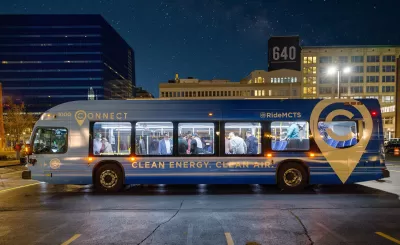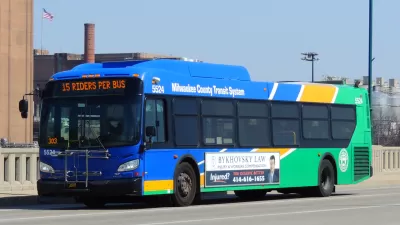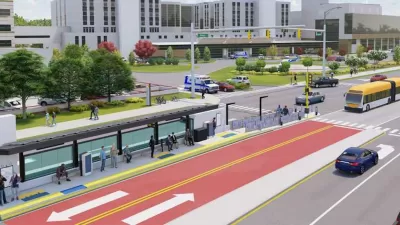The nine-mile route covers the city’s busiest east-west corridor and will offer free rides through the summer.

Milwaukee celebrated the opening of its first bus rapid transit (BRT) line last weekend, reports Graham Kilmer in Urban Milwaukee. “The system promises faster travel times through a mix of dedicated lanes, traffic signal priority, off-bus ticketing and dedicated stations.”
The nine-mile line uses electric buses, promises headways of 10 to 15 minutes, and will offer free rides until the end of September. The BRT stations feature “glass shelters, elevated platforms, digital signs showing real-time bus arrivals and off-bus fare validators.” Connect 1 runs parallel to Interstate 94.
According to the Milwaukee County Transit System (MCTS), “Ridership will be fueled by activity generators within the half-mile station area around the route including: 9 colleges and universities and 8 high schools, 48,900 residents, 110,700 jobs, 200 businesses with 100 or more employees, 8 medical facilities, 25+ hotels, and countless attractions including the county zoo, American Family Field, Fiserv Forum, Milwaukee Art Museum and Summerfest.”
FULL STORY: Milwaukee’s First Bus Rapid Transit Line Is Open for Business

Study: Maui’s Plan to Convert Vacation Rentals to Long-Term Housing Could Cause Nearly $1 Billion Economic Loss
The plan would reduce visitor accommodation by 25,% resulting in 1,900 jobs lost.

North Texas Transit Leaders Tout Benefits of TOD for Growing Region
At a summit focused on transit-oriented development, policymakers discussed how North Texas’ expanded light rail system can serve as a tool for economic growth.

Why Should We Subsidize Public Transportation?
Many public transit agencies face financial stress due to rising costs, declining fare revenue, and declining subsidies. Transit advocates must provide a strong business case for increasing public transit funding.

How to Make US Trains Faster
Changes to boarding platforms and a switch to electric trains could improve U.S. passenger rail service without the added cost of high-speed rail.

Columbia’s Revitalized ‘Loop’ Is a Hub for Local Entrepreneurs
A focus on small businesses is helping a commercial corridor in Columbia, Missouri thrive.

Invasive Insect Threatens Minnesota’s Ash Forests
The Emerald Ash Borer is a rapidly spreading invasive pest threatening Minnesota’s ash trees, and homeowners are encouraged to plant diverse replacement species, avoid moving ash firewood, and monitor for signs of infestation.
Urban Design for Planners 1: Software Tools
This six-course series explores essential urban design concepts using open source software and equips planners with the tools they need to participate fully in the urban design process.
Planning for Universal Design
Learn the tools for implementing Universal Design in planning regulations.
Ascent Environmental
Borough of Carlisle
Institute for Housing and Urban Development Studies (IHS)
City of Grandview
Harvard GSD Executive Education
Toledo-Lucas County Plan Commissions
Salt Lake City
NYU Wagner Graduate School of Public Service





























